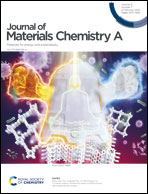Triazine derivatives as organic phase change materials with inherently low flammability†
Abstract
A series of triazine-based compounds (M1–M7) have been prepared starting from 1,3,5-triazine, 2,4,6-triamino-1,3,5-triazine (melamine), 2,4-dichloro-6-methoxy-1,3,5-triazine and 2-chloro-4,6-dimethoxy-1,3,5-triazine via either alkylation or amidation, and their thermal phase change properties were studied. Depending on the functional group introduced, the melting point of these 1,3,5-triazine derivatives ranged from 43 °C to 190 °C, while the enthalpy change of melting ranged from 47 to 150 J g−1. Vertical burning tests showed that most of these compounds required a lower amount of flame retardants to achieve self-extinguishing properties as compared to paraffin. Cone calorimetry studies of compound M1 showed that the peak heat release rate (pHRR) is reduced by about 30% from 1908 (for a paraffin/malamine (23%) blend) to 1359 kW m−2, while the average heat release rate is lowered by about 25% from 854 to 655 kW m−2. These studies indicate that triazine derivatives can serve as intrinsically flame-retardant phase change materials and partially address the flammability issue of existing organic phase change materials. This also demonstrates the superiority of chemical bonding as a means of introducing flame retardants as compared to physical blending.



 Please wait while we load your content...
Please wait while we load your content...